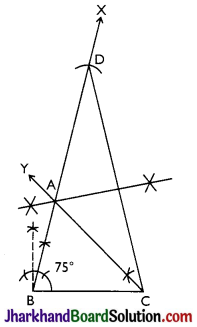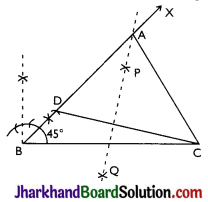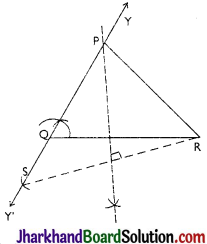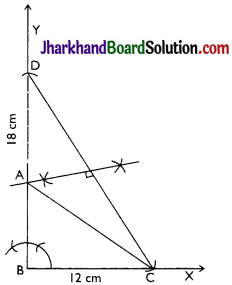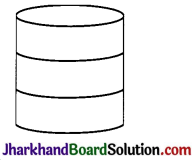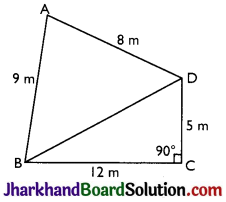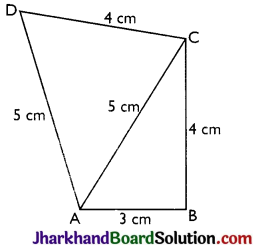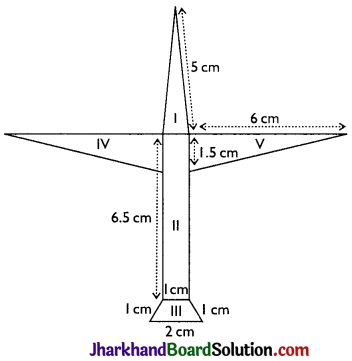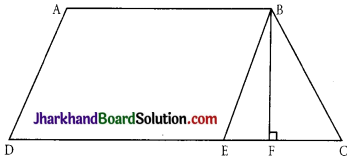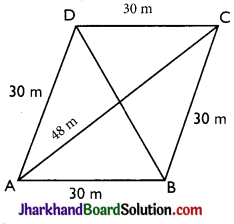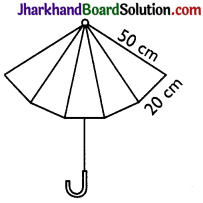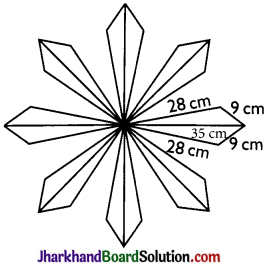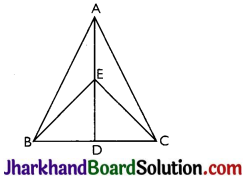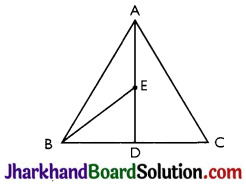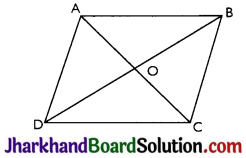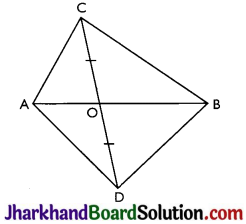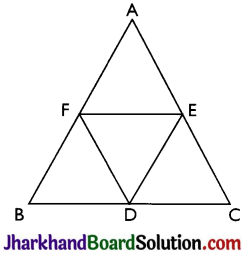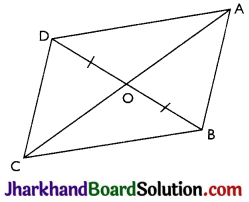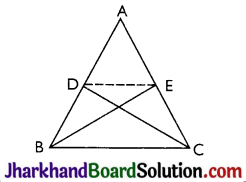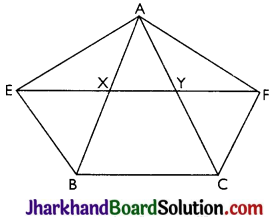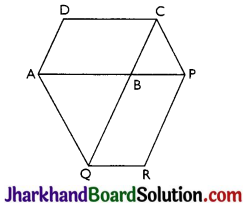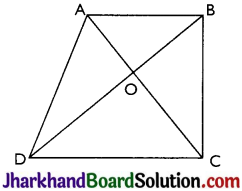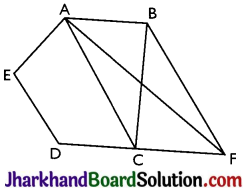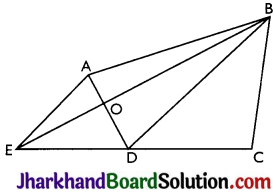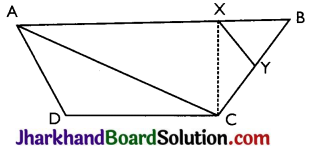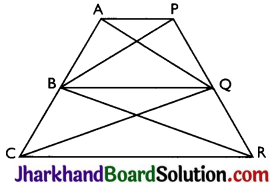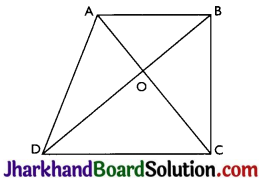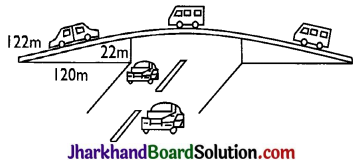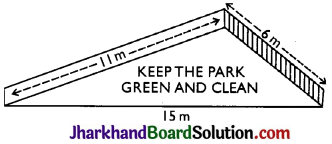Jharkhand Board JAC Class 10 Sanskrit Solutions Shemushi Chapter 10 भूकम्पविभीषिका Textbook Exercise Questions and Answers.
JAC Board Class 10th Sanskrit Solutions Shemushi Chapter 10 भूकम्पविभीषिका
JAC Class 10th Sanskrit भूकम्पविभीषिका Textbook Questions and Answers
प्रश्न 1.
एकपदेन उत्तरं लिखत (एक शब्द में उत्तर लिखिये)
(क) कस्य दारुण विभीषिका गुर्जरक्षेत्रं ध्वंसावशेषेषु परिवर्तितवती?
(किसकी दारुण विभीषिका ने गुजरात क्षेत्र को ध्वंसावशेषों में परिणित कर दिया?)
(ख) कीदृशानि भवनानि धाराशायीनि जातानि?
(कैसे भवन धराशायी हो जाते हैं?)
(ग) दुर्वार-जलधाराभिः किमुपस्थितम्?
(कठिनाई से रोके जाने वाली जल धाराओं ने क्या उपस्थित कर दिया?)
(घ) कस्य उपशमनस्य स्थिरोपायः नास्ति?
(किसको शान्त करने का स्थिर उपाय नहीं है?)
(ङ) कीदृशाः प्राणिनः भूकम्पेन निहन्यन्ते ?
(कैसे प्राणी भूकम्प द्वारा नष्ट कर दिये जाते हैं ?)
उत्तराणि :
(क) भूकम्पस्य (भूकम्प की)
(ख) बहुभूमिकानि (बहुमञ्जिले)
(ग) महाप्लावनदृश्यम् (महान बाढ़ के दृश्य को)
(घ) भूकम्पस्य (भूकम्प के)
(ङ) विवशा (मजबूर)
प्रश्न 2.
अधोलिखितानां प्रश्नानाम् उत्तराणि संस्कृतभाषया लिखत –
(निम्नलिखित प्रश्नों के उत्तर संस्कृत भाषा में लिखिए)
(क) समस्तराष्ट्र कीदृक् उल्लासे मग्नम् आसीत् ?
(सारा राष्ट्र कैसे उल्लास में मग्न था ?)
उत्तरम् :
समस्तराष्ट्रं नृत्य-गीतवादित्राणाम् उल्लासे मग्नम् आसीत्।।
(सम्पूर्ण राष्ट्र नाच-गान और वादनों के उल्लास में डूबा हुआ था।)

(ख) भूकम्पस्य केन्द्रभूतं किं जनपदः आसीत् ?
(भूकम्प का केन्द्रस्थित जनपद कौन-सा था ?)
उत्तरम् :
भूकम्पस्य केन्द्रभूतं कच्छजनपदः आसीत्।
(भूकम्प का केन्द्रस्थित भुज जनपद था।)
(ग) पृथिव्याः स्खलनात् किं जायते ?
(पृथ्वी के स्खलन से क्या पैदा होता है ?)
उत्तरम् :
पृथिव्याः स्खलनात् बहुभूमिकानि भवनानि क्षणेनैव पतन्ति। विद्युद्दीपस्तम्भाः पतन्ति। गृहसोपानमार्गाः विशीर्यन्ते।
भूमिः फालद्वये विभक्ता भवति। भूमिग दुपरि निस्सरन्तीभिः दुर्वारजलधाराभिः महाप्लावनदृश्यम् उपतिष्ठति। (पृथ्वी के अपने स्थान से खिसकने (हिलने) से बहुमंजिले मकान पलभर में गिर जाते हैं। बिजली के खम्भे गिर जाते हैं। घरों की सीढ़ियाँ टूटकर बिखर जाती हैं। भूमि दो भागों में बँट जाती है। पृथ्वी के भीतरी भाग से निकलने वाली अनियंत्रित जलधाराओं से बाढ़ जैसा दृश्य उपस्थित हो जाता है।)।
(घ) समग्रो विश्वः कैः आतङ्कितः दृश्यते ?
(सम्पूर्ण विश्व किनसे आतङ्कित दिखाई देता है ?)।
उत्तरम् :
समग्रो विश्वः भूकम्पैः आतङ्कितः दृश्यते।
(सम्पूर्ण संसार भूकम्पों से आतङ्कित दिखाई देता है।)

(ङ) केषां विस्फोटैरपि भूकम्पो जायते ?
(किनके विस्फोटों से भी भूकम्प पैदा होता है ?)
उत्तरम् :
ज्वालामुखपर्वतानां विस्फोटैरपि भूकम्पो जायते। (ज्वालामुखी पर्वतों के विस्फोटों से भी भूकम्प पैदा होता है।)
प्रश्न 3.
रेखांकितपदानि आधृत्य प्रश्ननिर्माणं कुरुत –
(रेखांकित शब्दों के आधार पर प्रश्नों का निर्माण कीजिए-)
(क) भूकम्पविभीषिका विशेषेण कच्छजनपदं ध्वंसावशेषेषु परिवर्तितवती।।
(भूकम्प की विभीषिका ने विशेषतः कच्छ जिले को ध्वंसावशेषों में परिवर्तित कर दिया।)
उत्तरम् :
भूकम्पविभीषिका विशेषेण कच्छजनपदं केषु परिवर्तितवती ?
(भूकम्प की विभीषिका ने विशेषतः कच्छ जिले को किसमें परिवर्तित कर दिया ?)
(ख) वैज्ञानिकाः कथयन्ति यत् पृथिव्याः अन्तर्गर्भे, पाषाणशिलानां संघर्षणेन कम्पनं जायते।
(वैज्ञानिक कहते हैं कि पृथ्वी के गर्भ में पत्थर की शिलाओं के रगड़ने से कम्पन पैदा होता है।)
उत्तरम् :
के कथयन्ति यत् पृथिव्याः अन्तर्गर्भ, पाषाणशिलानां संघर्षणेन कम्पनं जायते ?
(कौन कहते हैं कि पृथ्वी के गर्भ में पत्थर की शिलाओं की रगड़ से कंपन पैदा होता है ?)
(ग) विवशाः प्राणिनः आकाशे पिपीलिकाः इव निहन्यन्ते।
(विवश प्राणी आकाश में चींटी की तरह मारे जाते हैं।)
उत्तरम् :
विवशाः प्राणिनः कस्मिन् स्थाने (कुत्र) पिपीलिकाः इव निहन्यन्ते ?
(विवश प्राणी किस स्थान पर (कहाँ) चींटी की तरह मारे जाते हैं ?)
(घ) एतादृशी भयावहघटना गढवालक्षेत्रे घटिता।
(ऐसी भयानक घटना गढ़वाल क्षेत्र में घटी थी।)
उत्तरम् :
कीदृशी भयावहघटना गढवालक्षेत्रे घटिता ?
(कैसी भयानक घटना गढ़वाल क्षेत्र में घटी थी ?)

(ङ) तदिदानीम् भूकम्पकारणं विचारणीयं तिष्ठति।
(तो अब भूकम्प का कारण विचारणीय है।)
उत्तरम् :
तदिदानीम् किं विचारणीयं तिष्ठति ?
(तो अब क्या विचारणीय है ?)
प्रश्न 4.
‘भूकम्पविषये’ पञ्चवाक्यमितम् अनुच्छेदं लिखत – (भूकम्प के विषय में पाँच वाक्यों का अनुच्छेद लिखिये-)
उत्तरम् :
भूकम्पेन प्रकृतेः सन्तोलनं नश्यति। प्रकृतेः असन्तोलनस्य भीषणः परिणामः भवति। भूकम्पेन बहुभूमिकानि भवनानि क्षणमात्रेण ध्वस्तानि भवन्ति। पतितेषु भवनेषु बहवः प्राणिनः मृत्युं प्राप्नुवन्ति। एवं भूकम्पेन भीषणा क्षतिः भवति। (भूकम्प से प्राकृतिक सन्तुलन बिगड़ जाता है। प्रकृति के असंतुलन का भीषण परिणाम होता है। भूकम्प से बहुमंजिले मकान पलभर में गिर जाते हैं। गिरे हुए मकानों में बहुत-से प्राणी मर जाते हैं। इस प्रकार भूकम्प से भयंकर हानि होती है।)
प्रश्न 5.
कोष्ठकेष दत्तेष धातष निर्देशानसारं परिवर्तनं विधाय रिक्तस्थानानि परयत –
(कोष्ठक में दी हुई धातुओं में निर्देश के अनुसार परिवर्तन करके रिक्तस्थानों की पूर्ति कीजिए)
(क) समग्रं भारतं उल्लासे मग्नः ……………. (अस् + लट् लकारे)
(ख) भूकम्पविभीषिका कच्छजनपदं विनष्टं …………. (कृ + क्तवतु + ङीप्)
(ग) क्षणेनैव प्राणिनः गृहविहीनाः ………….. (भू + लङ्, प्रथमपुरुष, बहुवचन)
(घ) शान्तानि पञ्चतत्त्वानि भूतलस्य योगक्षेमाभ्याम् ………. (भू + लट्, प्रथमपुरुष, बहुवचन)
(ङ) मानवाः ……………….. यत् बहुभूमिकभवननिर्माणं करणीयं न वा? (पृच्छ + लट्, प्रथमपुरुष, बहुवचन)
(च) नदीवेगेन ग्रामाः तदुदरे ……………… (सम् + आ + विश् + विधिलिङ्, प्रथमपुरुष, एकवचन)
उत्तरम् :
(क) अस्ति
(ख) कृतवती
(ग) अभवन्
(घ) भवन्ति
(ङ) पृच्छन्ति
(च) समाविशे

प्रश्न 6.
(अ) सन्धिं/सन्धिविच्छेदं च कुरुत (सन्धि तथा सन्धि-विच्छेद कीजिए।)
(अ) परसवर्णसन्धिनियमानुसारम् (परसवर्ण सन्धि के नियमानुसार)
(क) किञ्च = ………..+ च।
(ख) ………… = नगरम् + तु।
(ग) विपन्नञ्च = ……….. + ……….।
(घ) ………… = किम् + नु।
(ङ) भुजनगरन्तु = …………… + ………..।
(च) ………… = सम् + चयः।
उत्तर :
(क) किञ्च = किं + च।
(ख) नगरन्तु = नगरम् + तु।
(ग) विपन्नञ्च = विपन्नम् + च।
(घ) किन्नु = किम् + नु।
(ङ) भुजनगरन्तु = भुजनगरम् + तु।
(च) सञ्चयः = सम् + चयः।
(आ) विसर्गसन्धिनियमानसारम (विसर्गसन्धि के नियमानुसार)
(क) शिशवस्तु = …….. + …….।
(ख)………… = विस्फोटैः + अपि।
(ग) सहस्रशोऽन्ये =……….+ अन्ये।
(घ) विचित्रोऽयम् = विचित्रः + ……।
(ङ) ……… = भूकम्पः + जायते।
(च) वामनकल्य एव = …….. + ……..।
उत्तरम् :
(क) शिशवस्तु = शिशवः + तु।
(ख) विस्फोटैरपि = विस्फोट: + अपि।
(ग) सहस्रशोऽन्ये = सहस्रशः + अन्ये।
(घ) विचित्रोऽयम् = विचित्रः + अयम्।
(ङ) भूकम्पो जायते = भूकम्प: + जायते।
(च) वामनकल्प एव = वामनकल्पः + एव।

प्रश्न 7.
(अ) ‘क’ स्तम्भे पदानि दत्तानि ‘ख’ स्तम्भे विलोमपदानि, तयोः संयोगं करुत
(‘क’ स्तम्भ में दिए गए पदों को ‘ख’ स्तम्भ में दिए गए उनके विलोम पदों से मिलाइए-)
(क) – (ख)
सम्पन्नम् – प्रविशन्तीभिः
ध्वस्तभवनेषु – सुचिरेणैव
निस्सरन्तीभिः – विपन्नम्
निर्माय – नवनिर्मितभवनेषु
क्षणेनैव – विनाश्य
उत्तर :
(क) – (ख)
सम्पन्नम् – विपन्नम्
ध्वस्तभवनेषु – नवनिर्मितभवनेषु
निस्सरन्तीभिः – प्रविशन्तीभिः
निर्माय – विनाश्य
क्षणेनैव – सुचिरेणैव
(आ) ‘क’ स्तम्भे पदानि दत्तानि ‘ख’ स्तम्भे समानार्थकपदानि तयोः संयोगं कुरुत- (माध्यमिक परीक्षा, 2013) (‘क’ स्तम्भ में पद दिए हुए हैं और ‘ख’ स्तम्भ में उनके समानार्थी पद हैं, उन दोनों का मेल कीजिए-)
(क) – (ख)
पर्याकुलम् – नष्टाः
विशीर्णाः – क्रोधयुक्ताम्
उगिरन्तः – संत्रोट्य
विदार्य – व्याकुलम्
प्रकुपिताम् – प्रकटयन्तः
उत्तर :
(क) – (ख)
पर्याकुलम् – व्याकुलम्
विशीर्णाः – नष्टाः
उगिरन्तः – प्रकटयन्तः
विदार्य – संत्रोट्य
प्रकुपिताम् – क्रोधयुक्ताम्

प्रश्न 8.
(अ) उदाहरणमनुसृत्य प्रकृति-प्रत्ययोः विभागं कुरुत
(उदाहरण के अनुसार प्रकृति-प्रत्यय को पृथक् कीजिए-)
यथा – परिवर्तितवती – परि + वृत् + क्तवतु + ङीप् (स्त्री)
- धृतवान् – …………. + …………..
- हसन् …………. + …………..
- विशीर्णा – वि + श + क्त + ………..
- प्रचलन्ती – …………. + ………….. + शतृ + ङीप् (स्त्री)
- हतः – …………. + …………..
उत्तरम् :
- धृतवान् ‘- धृ + क्तवतु
- हसन् – हस् + शत्र
- विशीर्णा – वि + शृ + क्त + टाप् (स्त्री)
- प्रचलन्ती – प्र + चल् + शतृ + ङीप् (स्त्री)
- हतः – हन् + क्त

(आ) पाठात् विचित्य समस्तपदानि लिखत – (पाठ से चुनकर समस्त पद लिखिए-)
(क) महत् च तत् कम्पनम् = …………
(ख) दारुणा च सा विभीषिका = …………
(ग) ध्वस्तेषु च तेषु भवनेषु = …………
(घ) प्राक्तने च तस्मिन् युगे = ………
(ङ) महत् च तत् राष्ट्र तस्मिन् = …………
उत्तरम् :
(क) महाकम्पनम्
(ख) दारुणविभीषिका
(ग) ध्वस्तभवनेषु
(घ) प्राक्तनयुगे
(ङ) महाराष्ट्रे।
JAC Class 10th Sanskrit भूकम्पविभीषिका Important Questions and Answers
शब्दार्थ चयनम् –
अधोलिखित वाक्येषु रेखांकित पदानां प्रसङ्गानुकूलम् उचितार्थ चित्वा लिखत –
प्रश्न 1.
भारतराष्ट्र नृत्य-गीत-वादित्राणाम् उल्लासे मग्नमासीत् –
(अ) प्रसन्नतायाम्
(ब) प्रमादे
(स) भग्न
(द) दुखे
उत्तरम् :
(अ) प्रसन्नतायाम्
प्रश्न 2.
विशीर्णाः गृहसोपान-मार्गाः।
(अ) विभीषिका
(ब) नष्य
(स) विशेषेण
(द) भूकम्पस्य
उत्तरम् :
(ब) नष्य

प्रश्न 3.
फालद्वये विभक्ता
(अ) संपुज्य
(ब) धराः
(स) विभाजिता
(द) निस्सरन्तीभिः
उत्तरम् :
(स) विभाजिता
प्रश्न 4.
द्वित्राणि दिनानि जीवनं धारितवन्तः।
(अ) सहस्रमिताः
(ब) सहायतार्थम्
(स) मृतप्रायाः
(द) प्राणान्.
उत्तरम् :
(द) प्राणान्.
प्रश्न 5.
इयमासीत् भैरवविभीषिका कच्छभूकम्पस्य।
(अ) भीषण
(ब) ऋजु
(स) दुर्बलः
(द) कटु
उत्तरम् :
(अ) भीषण

प्रश्न 6.
तदैव भयावहकम्पनं धराया
(अ) प्रकम्पते
(ब) प्रथिव्याः
(स) कथयन्ति
(द) संघर्षण
उत्तरम् :
(ब) प्रथिव्याः
प्रश्न 7.
विस्फोटैरपि भूकम्पो जायत इति कथयन्ति- .
(अ) कथम्
(ब) सञ्चयम्
(स) वदन्ति
(द) सर्वमेव
उत्तरम् :
(स) वदन्ति
प्रश्न 8.
ज्वालामुगिरन्त एते पर्वता अपि भीषणं भूकम्पं जनयन्ति।
(अ) नदीवेगेन
(ब) ग्रामाः
(स) पर्वताः
(द) उत्पादयन्ति
उत्तरम् :
(द) उत्पादयन्ति

प्रश्न 9.
यद्यपि दैवः प्रकोपो भूकम्पो नाम
(अ) ईश्वरीयः
(ब) उपशमनस्य
(स) कोऽपि
(द) तथापि
उत्तरम् :
(अ) ईश्वरीयः
प्रश्न 10.
अशान्तानि खलु तान्येव महाविनाशम् उपस्थापयन्ति।
(अ) तटबन्धम्
(ब) वस्तुतः
(स) मित्र
(घ) रिपुः
उत्तरम् :
(ब) वस्तुतः
संस्कृतमाध्यमेन प्रश्नोत्तराणि –
एकपदेन उत्तरत (एक शब्द में उत्तर दीजिए)
प्रश्न 1.
भूकम्पेन भुजनगरं कीदृशं जातम् ?
(भुजनगर भूकम्प से कैसा हो गया?)
उत्तरम् :
खण्ड-खण्डम् (टुकड़े-टुकड़े)।

प्रश्न 2.
कीदृशानि भवनानि धराशायीनि जातानि ?
(कैसे भवन धराशायी हो गये ?)
उत्तरम् :
बहुभूमिकानि (बहुमंजिले)।
प्रश्न 3.
भूकम्पेन क्षणेन कति मानवाः मृताः ?
(भूकम्प से क्षणभर में कितने मनुष्य मर गये ?)
उत्तरम् :
सहस्रमिताः (हजारों)।
प्रश्न 4.
ध्वस्तभवनेषु सम्पीडिताः मानवाः किं कुर्वन् आसन् ?
(ध्वस्त भवनों में पीड़ित मनुष्य क्या कर रहे थे ?)
उत्तरम् :
करुणक्रन्दनम् (करुण क्रन्दन)।

प्रश्न 5.
बृहत्यः पाषाणशिलाः कस्मात् कारणात् त्रुट्यन्ति ?
(विशाल पत्थर की शिलाएँ किस कारण से टूटती हैं ?)
उत्तरम् :
संघर्षणवशात् (घर्षण के कारण)।
प्रश्न 6.
पृथिव्याः स्खलनात् किं जायते ?
(पृथ्वी के स्खलन से क्या होता है ?)
उत्तरम् :
महाविनाशम् (महाविनाश)।
प्रश्न 7.
अग्निः शिलादिसञ्चयं किं करोति ?
(आग शिला आदि संचय का क्या करती है ?)
उत्तरम् :
क्वथयति (उबाल देती है)।
प्रश्न 8.
गगनं केन आवृणोति? (आकाश किससे ढक जाता है ?)
उत्तरम् :
धूमभस्माभ्याम् (धुआँ और राख से)।

प्रश्न 9.
प्रकृतेः असन्तुलनवशात् किं सम्भवति ?
(प्रकृति के असन्तुलन के कारण क्या होता है ?)
उत्तरम् :
भूकम्पः (पृथ्वी का हिलना)।
प्रश्न 10.
एकस्मिन् स्थले किं न पुञ्जीकरणीयम् ?
(एक जगह पर क्या एकत्रित नहीं करना चाहिए ?)
उत्तरम् :
नदीजलम् (नदियों का पानी)।
प्रश्न 11.
भूकम्पावसरे भारतराष्ट्र केषाम् उल्लासे मग्नमासीत् ?
(भूकम्प के अवसर पर भारत राष्ट्र किसके उल्लास में डूबा हुआ था ?)
उत्तरम् :
गणतन्त्र-दिवस-पर्वणि (गणतन्त्र दिवस समारोह में)।

प्रश्न 12.
भूकम्पस्य दारुण-विभीषिका कस्मिन् जनपदे आसीत् ?
(भूकम्प की भयंकर घटना किस जिले में थी ?)
उत्तरम् :
कच्छजनपदे (कच्छ जिले में)।
प्रश्न 13.
कति फाले विभक्ता भूमिः ?
(भूमि कितने भागों में बँट गई ?)
उत्तरम् :
फालद्वये (दो भागों में)।
प्रश्न 14.
भूमिग दुपरि निस्सरन्तीभिः दुरजलधाराभिः किं दृश्यम् उपस्थितम् ?
(धरती के भीतरी भाग से ऊपर निकलती अनियंत्रित जलधाराओं से क्या दृश्य उपस्थित हो गया ?)
उत्तरम् :
महाप्लावनम् (भयंकर बाढ़ का)।
प्रश्न 15.
कच्छजनपदे कस्य भैरवविभीषिका आसीत् ?
(कच्छजनपद में किसकी भयंकर विभीषिका थी ?)
उत्तरम् :
भूकम्पस्य (भूकम्प की)।

प्रश्न 16.
कस्याः अन्तर्गर्भे बृहत्यः पाषाणशिलाः विद्यमानाः भवन्ति ?
(किसके भीतरी भाग में पत्थर की बड़ी-बड़ी शिलाएँ मौजूद होती हैं ?)
उत्तरम् :
पृथिव्याः (धरती के)।
प्रश्न 17.
ग्रामाः नगराणि च कस्मिन् समाविशन्ति ?
(गाँव और नगर किसमें समाविष्ट हो जाते हैं ?)
उत्तरम् :
लावारसोदरे (लावे के अन्दर)।

प्रश्न 18.
केषां विस्फोटैः भूकम्पः जायते ?
(किनके विस्फोट से भूकंप पैदा होता है ?)
उत्तरम् :
ज्वालामुखपर्वतानाम् (ज्वालामुखी पहाड़ों के)।
प्रश्न 19.
अद्यापि विज्ञानगर्वितः मानवः कीदृशः अस्ति ?
(आज भी विज्ञान से गर्वित मानव कैसा है ?)
उत्तरम् :
वामनकल्पः (बौना-सा)।
प्रश्न 20.
केषां प्रकोपः भूकम्पः अस्ति ?
(भूकम्प किनका प्रकोप है ?)
उत्तरम् :
देवानाम् (देवताओं का)।

पूर्णवाक्येन उत्तरत (पूरे वाक्य में उत्तर दीजिए)
प्रश्न 21.
भूकम्पेन कच्छजनपदस्य का दशा अभवत् ?
(भूकम्प से कच्छ जिले की क्या स्थिति हो गई ?)
उत्तरम् :
भूकम्पेन कच्छ जनपदं ध्वंसावशेषु परिवर्तितम्।
(भूकम्प से कच्छ जिला खण्डहरों में बदल गया।)
प्रश्न 22.
सहस्रमिता: प्राणिनः कथं मृताः ?
(हजारों प्राणी कैसे मर गये ?)
उत्तरम् :
भूकम्पस्य विभीषिकया सहस्रमिताः प्राणिनः मृताः।
(भूकम्प की विभीषिका से हजारों प्राणी मर गये।)
प्रश्न 23.
भूकम्पात् किं भवति ?
(भूकम्प से क्या होता है ?)
उत्तरम् :
भूकम्पात् अपार-जन-धन-हानिः भवति।
(भूकम्प से अपार जन और धन की हानि होती है।)

प्रश्न 24.
पृथिव्याः गर्भे विद्यमानोऽग्निः किं करोति?
(धरती के गर्भ में स्थित आग क्या करती है ?)
उत्तरम् :
पृथिव्याः गर्भे विद्यमानोऽग्निः खनिजमृत्तिकाशिलादि सञ्चयं क्वथयति।
(पृथ्वी के गर्भ में स्थित आग खनिज-मिट्टी की शिलाओं के संचय को उबालती है।)
प्रश्न 25.
मानवः वामनकल्पः कुत्र भवति ? (मनुष्य बौने के समान कहाँ होता है ?)
प्रकत्याः समक्षं मानवः वामनकल्पः एव भवति।
(प्रकृति के समक्ष मानव बौना-सा ही होता है।)
प्रश्न 26.
भूकम्पेन गुर्जरराज्यं कीदृशम् अभवत् ?
(भूकम्प से गुजरात राज्य कैसा हो गया ?)
उत्तरम् :
भूकम्पेन गुर्जर-राज्यं पर्याकुलं, विपर्यस्तं क्रन्दनविकलं च जातम्।
(भूकम्प से गुजरात राज्य चारों ओर से व्याकुल, अस्त-व्यस्त तथा क्रन्दन से व्याकुल हो गया।)
प्रश्न 27.
महाप्लावनदृश्यं कथम् उपस्थितम्? (महाप्लावन का दृश्य कैसे उपस्थित हो गया ?)
उत्तरम् :
भूमिगर्भाद् उपरि निस्सरन्तीभिः दुरिजलधाराभिः महाप्लावनदृश्यम् उपस्थितम्।
(भूमि के गर्भ से ऊपर निकलती कठिनाई से रोकने योग्य जल की धाराओं से महाप्लावन का दृश्य उपस्थित हो गया।)

प्रश्न 28.
कश्मीरप्रान्ते कदा महाकम्पनम् आगतम् ?
(कश्मीर प्रान्त में महाभूकम्प कब आया ?)
उत्तरम् :
कश्मीरप्रान्ते पञ्चोत्तरद्विसहस्रख्रीष्टाब्दे भूकम्पम् आगतम्।
(कश्मीर प्रान्त में 2005 ई. में भूकम्प आया।)
प्रश्न 29.
भूकम्पः कैः अपि जायते ?
(भूकम्प किनसे भी पैदा होता है ?)
उत्तरम् :
भूकम्पः ज्वालामुखपर्वतानां विस्फोटः अपि जायते।
(भूकम्प ज्वालामुखी पर्वतों के विस्फोटों से भी पैदा होता है।)
प्रश्न 30.
कस्य स्थिरोपायो न दृश्यते ?
(किसका स्थायी उपचार नहीं दिखाई देता ?)
उत्तरम् :
भूकम्पोपशमनस्य कोऽपि स्थिरोपायः न दृश्यते।
(भूकम्प शान्ति का कोई स्थिर उपाय नहीं दिखाई देता।)
प्रश्ननिर्माणम् –
अधोलिखित वाक्येषु स्थूलपदमाधृत्य प्रश्ननिर्माणं कुरुत –
1. गुर्जरराज्ये एकोत्तरद्विसहस्त्रख्रीष्टाब्दे भूकम्पः जातः।
(गुजरात में 2001 ई. में भूकम्प आया।)
2. भूकम्पेन बहुभूमिकानि भवनानि क्षणेनैव धराशायीनि जातानि।
(भूकम्प से बहुमञ्जिले मकान क्षणभर में धराशायी हो गए।)
3. भूकम्पेन फालद्वये भूमिः विभक्ता।
(भूकम्प से धरती दो भागों में विभक्त हो गई।)
4. जलधाराभिः महाप्लावनदृश्यम् उपस्थितम्।
(जल की धाराओं से महान् बाढ़ का दृश्य पैदा हो गया।)
5. सहस्रमिताः प्राणिनस्तु क्षणेनैव भूकम्पेन मृताः।
(हजारों प्राणी क्षणभर में ही भूकम्प से मारे गए।)
6. ध्वस्तभवनेषु सम्पीडिताः क्रन्दन्ति स्म।
(ध्वस्त भवनों में पीड़ित (लोग) क्रन्दन कर रहे थे।)
7. शिशवः ईश्वरकृपया जीवनं धारितवन्तः।
(बच्चे ईश्वर की कृपा से जीवन धारण किए हुए थे।)
8. कश्मीरप्रान्ते पञ्चोत्तरद्विसहस्त्रख्रीष्टाब्दे धरायाः महत्कम्पनं जातम्।।
(कश्मीर प्रान्त में 2005 ई. में धरती का महान् कम्पन हुआ।)
9. कश्मीरे धरायाः महत्कम्पनात् लक्षपरिमिताः जनाः अकालकालकवलिताः।
(कश्मीर में धरती के महान् कम्पन से लाखों लोग असमय में काल के ग्रास बन गए।)
10. महाकम्पनेन महाविनाशदृश्यम् समुत्पद्यते।
(महाकम्पन से महाविनाश का दृश्य पैदा हो जाता है।)
उत्तराणि :
1. गुर्जरराज्ये कदा भूकम्पः जातः ?
2. भूकम्पेन कानि क्षणेनैव धराशायीनि जातानि ?
3. केन फालद्वये भूमिः विभक्ता ?
4. काभिः महाप्लावनदृश्यमुपस्थितम् ?
5. कति प्राणिनः क्षणेनैव भूकम्पेन मृताः ?
6. केषु सम्पीडिताः क्रन्दन्ति स्म ?
7. शिशवः कया जीवनं धारितवन्तः ?
8. कश्मीरप्रान्ते कदा धरायाः महत्कम्पनं जातम् ?
9. कश्मीरे जनाः अकालकालकवलिताः ?
10. केन महाविनाशदृश्यं समुत्पद्यते ?

पाठसार लेखनम –
प्रश्न :
‘भूकम्पविभीषिका’ इति पाठस्य सारांश: हिन्दीभाषायां लिखत।
उत्तरम् :
ईसवी सन् 2001 में गणतन्त्र दिवस समारोह में जिस समय सम्पूर्ण भारत देश तल्लीन था, उस समय अनायास ही धरती हिलने के भयंकर त्रास ने सारे ही गुजरात प्रदेश को विशेष रूप से कच्छ नाम के जनपद को खण्डहरों में बदल दिया था। केन्द्र बना भुजनामक नगर तो मिट्टी के खिलौने की तरह चकनाचूर हो गया था। अनेक मंजिलों वाले भवन तो क्षणमात्र में ही धराशायी हो गये। जल की धाराओं से महान् बाढ़ का दृश्य उपस्थित हो गया।
हजारों की संख्या में जीवधारी क्षण मात्र में ही मारे गये। घरों के नष्ट हो जाने पर पीड़ित हजारों की संख्या में दूसरे सहयोग के लिये अति करुण क्रन्दन कर रहे थे। हे विधाता! भूख से सूखे गले वाले मरणासन्न कुछ बच्चे भगवान् की कृपा से दो-तीन दिन तक ही प्राणों को धारण कर सके। कच्छ क्षेत्र में उत्पन्न भूकम्प की भयानक आपत्ति की यह स्थिति थी। ईशवी सन् 2005 में भी कश्मीर प्रदेश और पाकिस्तान देश में महान् भूकम्प आया।
जिसमें लाखों की संख्या में मानव असमय में ही मर गये। ‘धरती किस कारण से हिलती है। वैज्ञानिक इस विषय में कहते हैं कि पृथ्वी के आन्तरिक भाग में विद्यमान विशाल पत्थर की चट्टानें जिस समय आपस में टकराने से दुकड़े-टुकड़े हो जाती है उस समय भयंकर विचलन होता है। विचलन से उत्पन्न कम्पन्न उसी समय पृथ्वी के बाहरी तल पर आकर महान् कम्पन पैदा करता है। जिसके कारण अतिविनाश का दृश्य उत्पन्न हो जाता है।
ज्वालामुखी पर्वतों के विस्फोटों से भी भूकम्प होता है। ऐसा भूगर्भ रहस्य वेत्ताओं ने कहा है। भूकम्प दैवी प्रकोप है। परन्तु इसका कोई स्थायी शान्ति का कोई उपचार नजर नहीं आता है। प्रकृति के सामने आज भी मनुष्य बौना है। परंतु फिर भी भूकम्प के रहस्य को जानने वाले वैज्ञानिक कहते हैं कि बहुमञ्जिले भवनों का निर्माण नहीं करना चाहिये। पानी के बाँधों का निर्माण करके बड़ी मात्रा में नदी के जल को एक जगह संग्रह नहीं करना चाहिये। नहीं तो सन्तुलन के अभाव में भूकम्प सम्भव है।
भूकम्पविभीषिका Summary and Translation in Hindi
पाठ-परिचय – प्रकृति ने जहाँ हमें अनेक प्रकार के भौतिक सुख-साधन उपलब्ध कराए हैं, वहीं अनेक आपदाएँ भी प्रदान की हैं। कभी किसी महामारी की आपदा, बाढ़ तथा सूखे की आपदा या तूफान के रूप में भयंकर प्रलय। ये सभी आपदाएँ देखते-ही-देखते महाविनाश करके मानव-जीवन को अस्त-व्यस्त कर देती हैं। इन्हीं भयङ्कर आपदाओं में से एक है- भूकम्प। भूकम्प में पृथ्वी अकस्मात् काँपने लगती है। फलस्वरूप विशालकाय निर्माण, बहुमंजिले भवन, सड़कें और बिजली के खम्भे आदि गिरकर महाविनाश का कारण बनते हैं। प्रस्तुत पाठ इसी आपदा पर आधारित है। इस पाठ के माध्यम से बताया गया है कि किसी भी आपदा में बिना किसी घबराहट के, हिम्मत के साथ किस प्रकार हम अपनी सुरक्षा स्वयं कर सकते हैं।

मूलपाठः,शब्दार्थाः, सप्रसंग हिन्दी-अनुवादः
1. एकोत्तरद्विसहस्रनीष्टाब्दे (2001 ईस्वीये वर्षे) गणतन्त्र-दिवस-पर्वणि यदा समग्रमपि भारतराष्ट्र नृत्य-गीत-वादित्राणाम् उल्लासे मग्नमासीत् तदाकस्मादेव गुर्जर-राज्यं पर्याकुलं, विपर्यस्तम्, क्रन्दनविकलं, विपन्नञ्च जातम्। भूकम्पस्य दारुण-विभीषिका समस्तमपि गुर्जरक्षेत्रं विशेषेण च कच्छजनपदं ध्वंसावशेषु परिवर्तितवती। भूकम्पस्य केन्द्रभूतं भुजनगरं तु मृत्तिकाक्रीडनकमिव खण्डखण्डम् जातम्। बहुभूमिकानि भवनानि क्षणेनैव धराशायीनि जातानि। उत्खाता विद्युद्दीपस्तम्भाः। विशीर्णाः गृहसोपान-मार्गाः।
शब्दार्थाः – एकोत्तर द्विसहस्रख्रीष्टाब्दे = 2001 ईस्वीये वर्षे (सन् 2001 ईग्वी वर्ष में)। गणतन्त्र-दिवस-पर्वणि = गणतन्त्रदिवसोत्सवे (गणतन्त्र दिवस समारोह में)। यदा = यस्मिन् काले जब)। समग्रमपि भारतराष्ट्रम् = सम्पूर्णोऽपि भारतदेशः (सारा भारत राष्ट्र)। नृत्य-गीत-वादित्राणाम् = नर्तनस्य, गानस्य वाद्यवादनस्य च (नाच-गाने और बाजे बजाने के)। उल्लासे = प्रसन्नतायाम् (खुशी में)। मग्नमासीत् = तल्लीनः निमग्नः, व्यापृतः वा अवर्तत (डूबा हुआ था)। तदा = तस्मिन् काले (तब)। अकस्मादेव = अनायासमेव (अचानक ही)। गुर्जर-राज्यम् = गुजराताख्यं प्रान्तम् (गुजरात प्रान्त)। पर्याकुलम् = परितः व्याकुलम् (चारों ओर से बेचैन)। विपर्यस्तम् = अस्तव्यस्तम् (अस्तव्यस्त)। क्रन्दनविकलम् = चीत्कारेण व्याकुलम् (क्रन्दन, रुदन से बेचैन)।
विपन्नम् = विपत्तियुक्तम्, विपत्तिग्रस्तम् (मुसीबत में)। जातम् = अभवत्, अजायत (हो गया, पड़ गया)। भूकम्पस्य = धरादोलनस्य (धरती हिलने की)। दारुण = भयङ्करः (भयानक)। विभीषिका = त्रासः (भयंकर घटना ने)। समस्तमपि = सम्पूर्णमपि (सारे)। गुर्जरक्षेत्रम् = गुजरातप्रदेशम् (गुजरात प्रान्त को)। विशेषेण च = विशेषरूपेण च (और विशेष रूप से)। कच्छजनपदम् = कच्छाख्यं जनपदम् (कच्छ जिले को)। ध्वंसावशेषु = नाशोपरान्त-अवशिष्टेषु भग्नावशिष्टेषु (विनाश के बाद बचे हुए खंडहरों में)। परिवर्तितवती = परिणितम् अकरोत् (बदल दिया, परिणत कर दिया)। भूकम्पस्य = धरादोलनस्य (धरती हिलने के)। केन्द्रभूतम् = मध्येस्थितम् (मध्य में या केन्द्र स्थित)। भुजनगरं तु = भुजनामकं पुरं तु (भुजनगर तो)।
मृत्तिका-क्रीडनकमिव = (मिट्टी के खिलौने की तरह)। खण्डखण्डम् = विखण्डितम् (टुकड़े-टुकड़े)। जातम् = अभवत् (हो गया)। बहुभूमिकानि भवनानि = बहव्यः भूमिकाः येषु तानि भवनानि, अनेकतलगृहाणि (बहुमंजिले मकान)। क्षणेनैव = क्षणमात्रकालेन एव (क्षणभर में ही)। धराशायीनि जातानि = पृथिव्यां पतितानि (धरती पर गिर गए)। उत्खाताः = उत्पाटिताः (उखड़ गए)। विधुदीपस्तम्भाः = दामिनी-दीप-यूपाः (बिजली के खंभे)। विशीर्णाः = नष्टाः (टूट गए)। गृहसोपान-मार्गाः = भवनस्य आरोहणपद्धत्यः (झीने, सीढ़ियाँ)।
सन्दर्भ-प्रसङ्गश्च – यह गद्यांश हमारी ‘शेमुषी’ पाठ्य पुस्तक के ‘भूकम्पविभीषिका’ पाठ से उद्धृत है। यह पाठ भूकम्प की विभीषिका को दर्शाता है।
हिन्दी-अनुवादः – सन् 2001 ईस्वी वर्ष में जब सारा भारत राष्ट्र गणतन्त्र दिवस समारोह में नाचने, गाने और बजाने की खुशी में डूबा हुआ था तब अचानक ही गुजरात नामक प्रदेश चारों ओर से बेचैन, अस्तव्यस्त, क्रन्दन-रुदन से व्याकुल तथा विपत्तिग्रस्त हो गया। भूकम्प की भयंकर घटना ने सम्पूर्ण गुजरात प्रान्त को विशेष रूप से कच्छ जिले को भग्नावशेषों-खण्डहरों में बदल दिया। धरती हिलने के मध्य भाग में (केन्द्र में) स्थित भुज नामक नगर तो मिट्टी के खिलौने की तरह टुकड़े-टुकड़े हो गया। बहु-मंजिले मकान क्षण-भर में ही धराशायी हो गए अर्थात् गिर गए। बिजली के खम्भे उखड़ गए (और) झीने टूटकर बिखर गए अर्थात् मकानों में ऊपर जाने के लिए बनी सीढ़ियों के टुकड़े-टुकड़े हो गए।

2. फालद्वये विभक्ता भूमिः। भूमिग दुपरि निस्सरन्तीभिः दुरजलधाराभिः महाप्लावनदृश्यम् उपस्थितम्। सहस्रमिताः प्राणिनस्तु क्षणेनैव मृताः। ध्व इम्पीडिताः सहस्रशोऽन्ये सहायतार्थं करुणकरुणं क्रन्दन्ति स्म। हा दैव ! क्षत्क्षामकण्ठाः मृतप्रायाः केचन शिशवस्तु ईश्वरकृपया एव द्वित्राणि दिनानि जीवनं धारितवन्तः।
शब्दार्थाः – फालद्वये = खण्डद्वये, द्वयोः खण्डयोः (दो भागों में)। विभक्ता = विभाजिता (बँटी हुई)। भूमिः = धरा (धरती)। भूमिग दुपरि = पृथिव्या गर्भात् (धरती के अन्दर से)। निस्सरन्तीभिः = निर्गच्छन्तीभिः (निकलती हुई)। दुर्वार = दुःखेन निवारयितुं योग्यम् (अनियन्त्रित, जिनको रोकना कठिन है; न रोके जाने योग्य)। जलधाराभिः = तोयधाराभिः (पानी की धाराओं से)। महाप्लावनदृश्यम् = महत्प्लावनस्य दृश्यम् (भयंकर बाढ़ का दृश्य)। उपस्थितम् = प्रस्तुतम्, उपस्थितोऽजायत् (उपस्थित हो गया था)। सहस्रमिताः = सहस्रसंख्यकाः, सहस्रपरिमिताः (हजारों की संख्या में)। प्राणिनस्तु = जीवधारिणः तु (प्राणी तो)। क्षणेनैव = पलमात्रेण एव (पलभर में ही)। मृताः = हताः (मारे गए)।
ध्वस्तभवनेषु = विनष्टावासेषु, गृहेषु (गिरे हुए भवनों में)। सम्पीडिताः = पीडिताः (पीडित)। सहस्रशोऽन्ये = सहस्रसंख्यकाः अपरे (हजारों दूसरे)। सहायतार्थम् = सहयोगार्थम् (सहायता के लिए)। करुणकरुणम् = अतिकरुणया (करुणामय)। क्रन्दन्ति स्म = क्रन्दनं कुर्वन्ति स्म (क्रन्दन कर रहे थे)। हा दैव ! = हा विधातः ! (हाय विधाता)। क्षुत्क्षामकण्ठाः = क्षुधाक्षामः कण्ठाः येषाम् ते, बुभुक्षया दुर्बलस्वरः (भूख से दुर्बल स्वर वाले)। मृतप्रायाः = मरणासन्नाः (मरणासन्न)। केचन् = केचिद् (कुछ)। शिशवस्तु = बालाः तु (छोटे बच्चे तो)। ईश्वरकृपया एव = भगवत्कृपया एव (ईश्वर की कृपा से ही)। द्वित्राणि दिनानि = द्वे त्रीणि दिनानि वा (दो या तीन दिन)। जीवनम् =प्राणान् (प्राणों को)। धारितवन्तः =धृतवन्तः (धारण किया)।
सन्दर्भ-प्रसङ्गश्च – यह गद्यांश हमारी ‘शेमुषी’ पाठ्य-पुस्तक के ‘भूकम्पविभीषिका’ पाठ से लिया गया है। गद्यांश में भूकम्प द्वारा किये गये विनाश का चित्रण है।
हिन्दी-अनुवादः – धरती दो भागों में बँट गई। बैंटी हुई धरती के अन्दर से निकलती हुई न रोके जाने योग्य पानी की धाराओं से भयंकर बाढ़ का-सा दृश्य उपस्थित हो गया था। हजारों की संख्या में जीवधारी (प्राणी) तो पल-भर में ही मारे गए। गिरे हुए (ध्वस्त) भवनों में पीड़ित हजारों दूसरे सहयोग के लिए (सहायता के लिए) करुणापूर्ण क्रन्दन कर रहे थे। हाय विधाता ! भूख से दुर्बल कण्ठ (स्वर) वाले मरणासन्न कुछ बालक तो ईश्वर की कृपा से ही दो-तीन दिन प्राणों (जीवन) को धारण किए रहे अर्थात् जीवित रहे।

3. इयमासीत् भैरवविभीषिका कच्छभूकम्पस्य। पञ्चोत्तरद्विसहस्त्रनीष्टाब्दे (2005 ईस्वीये वर्षे) अपि कश्मीरप्रान्ते पाकिस्तानदेशे च धरायाः महत्कम्पनं जातम्। यस्मात्कारणात् लक्षपरिमिताः जनाः अकालकालकवलिताः। पृथ्वी कस्मात्प्रकम्पते वैज्ञानिकाः इति विषये कथयन्ति यत् पृथिव्या अन्तर्गर्भे विद्यमानाः बृहत्यः पाषाणशिला यदा संघर्षणवशात् त्रुट्यन्ति तदा जायते भीषणं संस्खलनम, संस्खलनजन्यं कम्पनञ्च। तदैव भयावहकम्पनं धराया उपरितलमप्यागत्य महाकम्पनं जनयति येन महाविनाशदृश्यं समुत्पद्यते।
शब्दार्थाः – इयम् = एषा (यह ऐसी)। कच्छभूकम्पस्य = कच्छक्षेत्रे आगतस्य धरादोलनस्य (कच्छ क्षेत्र में आए भूकम्प की)। भैरवविभीषिका = भीषणा आपदा (भयंकर घटना, भयावह आपदा)। आसीत् = अवर्तत (थी)। पञ्चोत्तरद्विसहस्रख्रीष्टाब्दे = 2005 ईस्वीये वर्षे (सन् 2005 ई. वर्ष में)। अपि = (भी)। कश्मीरप्रान्ते = शारदादेशे (कश्मीर में)। पाकिस्तानदेशे च = (पाकिस्तान देश में, और पाकिस्तान में)। धरायाः = भुवः, (पृथ्वी का)। महत्कम्पनम् = प्रभूतं महद्दोलनमजायत (बहुत अधिक कम्पन हुआ)। यस्मात् कारणात् = यस्मात् हेतोः (जिस कारण से, जिससे)।
लक्षपरिमिताः = शतसहस्रमिताः, शतसहस्रसंख्यकाः (लाखों की संख्या में)। जनाः = मनुष्याः, मानवाः (लोग)। अकालकालकवलिताः = असमये एव दिवंगताः (अकाल मृत्यु को प्राप्त हुए, असमय ही मर गये)। पृथ्वी = धरा (धरती)। कस्मात् = केन कारणेन (किस कारण से)। प्रकम्पते = दोलायते (हिलती है)। वैज्ञानिकाः = विज्ञानवेत्तारः (मौसम विज्ञान के जानकार)। इति विषये = अस्मिन् सन्दर्भे (इस विषय में)। कथयन्ति = वदन्ति (बोलते हैं, कहते हैं)। यत् = (कि)। पृथिव्याः अन्तर्गर्भे = धरायाः निम्नभागे, आन्तरिकभागे वा (पृथ्वी के केन्द्र भाग में)।
विद्यमानाः = उपस्थिताः (विद्यमान, मौजूद)। बृहत्यः = विशाला: (बड़ी-बड़ी)। पाषाण-शिलाः = प्रस्तर या भीतरी पट्टिकाः (पत्थर की शिलाएँ)। यदा = यस्मिन् काले (जब)। संघर्षणवशात् = परस्परघर्षणात् (आपस में टकराने से)। त्रुटयन्ति = भञ्जन्ति, खण्डखण्डं भवन्ति (टुकड़े-टुकड़े होती हैं)। तदा = तस्मिन् काले (तब)। भीषणं = भयंकरम् (भयंकर)। संस्खलनम् = विचलनम् (खिसकना, दूर हटना)। जायते = भवति (होता है)। संस्खलनजन्यम् = विचलनात् उत्पन्नम् (खिसकने से उत्पन्न)।
कम्पनञ्च = दोलनञ्च (हिलना, काँपना)। तदैव = तस्मिन्नेव काले (उसी समय, तभी)। भयावहकम्पनम् = भयंकरम् दोलनम् (भयानक कंपन)। धरायाः = पृथिव्याः (धरती के)। उपरितलमप्यागत्य = बाह्य तलं प्राप्य (ऊपर के तल पर आकर)। महाकम्पनम् = महद्दोलनम् (अत्यधिक कम्पन)। जनयति = उत्पन्नं करोति (पैदा करता है)। येन = येन कारणेन (जिससे)। महाविनाशदृश्यम् = (महाविनाश का दृश्य)। समुत्पद्यते = प्रादुर्भवति, उद्भवति (पैदा होता है)।
सन्दर्भ-प्रसङ्गश्च – यह गद्यांश हमारी ‘शेमुषी’ पाठ्य-पुस्तक के ‘भूकम्पविभीषिका’ पाठ से उद्धृत है। इस गद्यांश में सन् 2005 ईसवी में आये भूकम्प की भयानक विभीषिका का चित्रण है।
हिन्दी-अनुवादः- यह कच्छक्षेत्र में आई भूकम्प की भयंकर आपदा (घटना) थी। सन् 2005 ई. में भी कश्मीर प्रान्त में और पाकिस्तान देश में पृथ्वी का बहुत अधिक कम्पन हुआ, जिससे लाखों की संख्या में लोग अकाल मृत्यु को प्राप्त हुए अर्थात् असमय में ही मर गए। धरती किस कारण से काँपती है। मौसम विज्ञान के जानकार इस विषय में कहते हैं कि पृथ्वी के आन्तरिक (भीतरी) भाग में विद्यमान बड़ी-बड़ी पत्थर की शिलाएँ जब आपस में टकराने से टूटती हैं (टुकड़े-टुकड़े होती हैं) तब भयंकर स्खलन होता है। स्खलन से कम्पन उत्पन्न होता है। तभी भयानक कम्पन पृथ्वी के ऊपरी तल पर आकर अत्यधिक कम्पन उत्पन्न करता है, जिससे अत्यधिक विनाश का दृश्य पैदा होता है।

4. ज्वालामुखपर्वतानां विस्फोटैरपि भूकम्पो जायत इति कथयन्ति भूकम्पविशेषज्ञाः। पृथिव्याः गर्भे विद्यमानोऽग्निर्यदा खनिजमृत्तिकाशिलादिसञ्चयं क्वथयति तदा तत्सर्वमेव लावारसताम् उपेत्य दुरगत्या धरां पर्वतं वा विदार्य बहिनिष्क्रामति। धूमभस्मावृतं जायते तदा गगनम्। सेल्सियस-ताप-मात्राया अष्टशताङ्कता मुपगतोऽयं लावारसो यदा नदीवेगेन प्रवहति तदा पार्श्वस्थग्रामा नगराणि वा तदुदरे क्षणेनैव समाविशन्ति। निहन्यन्ते च विवशाः प्राणिनः। ज्वालामुदगिरन्त एते पर्वता अपि भीषणं भूकम्पं जनयन्ति।।
शब्दार्थाः – ज्वालामुखपर्वतानाम् = अग्न्याननगिरीणाम् (ज्वालामुखी पर्वतों के)। विस्फोटैरपि = विस्फोटै: अपि (विस्फोटों से भी)। भूकम्पो जायते = धरादोलनं भवति (धरती में कम्पन होता है) (इति = ऐसा)। भूकम्प-विशेषज्ञाः = भुवः कम्पन-रहस्यस्य ज्ञातारः (भूमि के काँपने के रहस्य को जानने वाले)। कथयन्ति = वदन्ति, आहुः, ब्रुवन्ति (कहते हैं)। पृथिव्याः = धरायाः (धरती के)। गर्भे = आन्तरिक-भागे (भीतरी भाग में)। विद्यमानः = स्थितः (उपस्थित)। अग्निः = अनलः, पावकः, हुताशनम् (आग)। यदा = यस्मिन् काले (जब)। खनिज = उत्खननात् प्राप्तं द्रव्यम् (खनिज)। मृत्तिका = मृद् (मिट्टी)। शिलादिसञ्चयम् = प्रस्तरपट्टिकादीनां संग्रहम् (शिला आदि के संचय को)। क्वथयति = उत्तप्तं करोति (उबालती है, तपाती है)। तदा = ततः (तब)। तत्सर्वमेव = तत्सम्पूर्णं, सकलमेव (वह सब ही)।
लावारसताम् = खनिद्रव-रसत्वम्, लावाद्रवत्वम् (लावा द्रवत्व को)। उपेत्य = प्राप्य (प्राप्त करके)। दुर्वारगत्या = अनियन्त्रित-वेगेन (अनियन्त्रित वेग से)। धराम् = पृथिवीम् (धरती को)। वा = अथवा। पर्वतम् = गिरिम् (पहाड़ को)। विदार्य = विदीर्णं कृत्वा (फाड़कर)। बहिर्निष्क्रामति = बहिर् निस्सरति, उपर्यागच्छति (बाहर निकलता है)। तदा = तस्मिन् काले (तब, उस समय)। गगनम् = आकाशमण्डलम् (आकाश)। धूमभस्मावृतं जायते = धूमेन, भस्मेन च आवृतं भवति (धुआँ और राख से ढक जाता है)। सेल्सियसतापमात्रायाः = तापस्य परिमाणमस्य सेल्सियसः (ताप के परिमाण की मात्रा का सेल्सियस)। अष्टशताकताम् = अष्टशत-अङ्कपर्यन्तम् (800 डिग्री तक)। उपगतो = उपेतः (प्राप्त हुआ)। अयम् = एषः (यह)। लावारसः = खनिद्रवप्रवाहः (लावा)। यदा = यस्मिन् काले (जिस समय)।
नदीवेगेन = तटिनी गत्या (नदी के वेग से)। प्रवहति = द्रवति (बहता है)। तदा = तरिमन् काले (उस समय)। पार्श्वस्थ = (समीप)। स्थिता: ग्रामाः = निकटस्थग्रामाः (पास या समीप में स्थित, आस-पास के)। ग्रामाः नगराणि वा = वसत्यः, पुराणि वा (गाँव अथवा नगर)। तदुदरे = तत् कुक्षौ, जठरे (उसके पेट में)। क्षणेनैव = पलमात्रेणैव (क्षणमात्र में ही)। समाविशन्ति = अन्तः गच्छन्ति, समाविष्टाः भवन्ति (समा जाते हैं)। निहन्यन्ते = म्रियन्ते (मारे जाते हैं)। विवशाः प्राणिनश्च = अवशाः जीव-जन्तवः (बेबस जीव-जन्तु)। ज्वालामुगिरन्तः = अग्निं प्रकटयन्तः वमन्तः (आग उगलते हुए)। एते पर्वताः = इमे गिरयः (ये पर्वत)। अपि = (भी)। भीषणम् = भयंकरम् (भयावह)। भूकम्पं जनयन्ति = धरादोलनं उत्पादयन्ति (भूकम्प को पैदा करते हैं)।
सन्दर्भ-प्रसङ्गश्च – यह गद्यांश हमारी ‘शेमुषी’ पाठ्य-पुस्तक के ‘भूकम्पविभीषिका’ पाठ से उद्धृत है। इस गद्यांश में भूकम्प के कारणों का उल्लेख किया गया है। ज्वालामुखी पर्वत का विस्फोट इनमें से प्रमुख है।
हिन्दी-अनुवादः – ज्वालामुखी पर्वतों के विस्फोटों से भी धरती काँपती (हिलती) है, ऐसा भूमि के काँपने के रहस्य को जानने वाले कहते हैं। धरती के गर्भ में स्थित आग जब खनिज, मिट्टी, शिला आदि के संचय (समूह) को उबालती (तपाती) है, तब वह सब ही लावा-द्रवत्व को प्राप्त होकर अनियन्त्रित वेग (गति) से धरती अथवा पहाड़ को फाड़कर (चीरकर) बाहर निकलता है। उस समय आकाश धुएँ और राख से ढक जाता है। ताप के परिमाण की मात्रा 800° सेल्सियस तक पहुँचा हुआ यह लावा जब नदी के वेग से बहता है, उस समय आस-पास के गाँव अथवा शहर उसके पेट में (गर्भ में) क्षणमात्र में समाविष्ट (विलीन) हो जाते हैं। विवश (बेबस) जीव-जन्तु मारे जाते हैं। आग उगलते हुए ये पर्वत भी भयंकर भूकम्प को पैदा करते हैं।

5 यद्यपि दैवः प्रकोपो भूकम्पो नाम, तस्योपशमनस्य न कोऽपि स्थिरोपायो दृश्यते। प्रकृति-समक्षमद्यापि विज्ञानगर्वितो मानवः वामनकल्प एव तथापि भूकम्परहस्यज्ञाः कथयन्ति यत् बहुभूमिकभवननिर्माणं न करणीयम्। तटबन्ध निर्माय बृहन्मानं नदीजलमपि नैकस्मिन् स्थले पुञ्जीकरणीयम् अन्यथा असन्तुलनवशाद् भूकम्पस्सम्भवति। वस्तुतः शान्तानि एव पञ्चतत्त्वानि क्षितिजलपावकसमीरगगनानि भूतलस्य योगक्षेमाभ्यां कल्पन्ते। अशान्तानि खलु तान्येव महाविनाशम् उपस्थापयन्ति।
शब्दार्थाः – भूकम्पः = धरादोलनम् (धरती का हिलना)। दैवः = ईश्वरीय (दैवीय)। प्रकोपः = प्रकृष्टः कोप: (अत्यधिक कोप है)। तस्य = (उसके)। उपशमनस्य = शान्तेः (शान्त करने का)। कोऽपि = कश्चिदपि (कोई भी)। स्थिरोपायो = स्थायी उपचारः (स्थायी इलाज)। न दृश्यते = न लक्ष्यते (दिखाई नहीं देता है)। प्रकृतिसमक्षम् = प्रकृत्याः, निसर्गस्य सम्मुखे (प्रकृति के सामने)। अद्यापि = अधुनापि, इदानीमपि (आज भी)। मानवः = मनुष्यः (मनुष्य)। वामनकल्प एव = ह्रस्वकायः सदृशः ह्रस्वः (बौने की तरह ही)। (अस्ति = है।) तथापि = पुनरपि (फिर भी)। भूकम्परहस्यज्ञाः = धरादोलनरहस्यविदः (धरती हिलने के रहस्य को जानने वाले)। कथयन्ति = ब्रुवन्ति, आहुः (कहते हैं)। यत् = कि। बहुभूमिकभवननिर्माणम् = अनेकतलोपेतानां गृहाणां सर्जनम् [अनेक तलों से (मंजिलों से) युक्त घरों का निर्माण)। न करणीयः = न कर्त्तव्यम् (नहीं करना चाहिए)।
तटबन्धम् = जलबंधम् (बाँध)। निर्माय = निर्माणं कृत्वा (बनाकर)। बृहन्मात्रम् = विशालमात्रम् (बहुत मात्रा में)। नदीजलमपि = सरित्तोयमपि (नदी का पानी भी)। एकस्मिन् स्थले = एकस्मिन्नेव स्थाने (एक ही स्थान पर)। न पुञ्जीकरणीयम् = नैकत्र करणीयम्, संग्रहणीयम् (इकट्ठा नहीं करना चाहिए)। अन्यथा = नहीं तो। असन्तुलनवशात् = सन्तुलनाभावात् (सन्तुलन के अभाव में)। भूकम्पः = धरादोलनम् (धरती का हिलना)। सम्भवति = सम्भाव्यमस्ति (सम्भव होता है)। वस्तुतः = यथार्थतः (वास्तव में)। शान्तानि एव = प्रशान्तान्येव (प्रशान्त ही)। पञ्चतत्त्वानि = पृथिव्यादिनि पञ्चतत्त्वानि (धरती आदि पाँच तत्त्व)।
क्षितिजलपावकसमीरगगनानि = पृथ्वी, आपः, अग्निः, वायुः, आकाशादीनि (पृथ्वी, जल, अग्नि, वायु, आकाश आदि)। भूतलस्य = धरातलस्य (पृथ्वीतल की)। योगक्षेमाभ्यां = अप्राप्तस्य प्राप्तिः, योगः प्राप्तस्य रक्षणम् (क्षेमः) ताभ्याम् (अप्राप्त की प्राप्ति और प्राप्त की रक्षा)। कल्पन्ते = रचयन्ति (रचना करते हैं)। अशान्तानि = शमनाभावे (शान्ति के अभाव में)। खलु = वस्तुतः (वास्तव में)। तान्येव = अमूनि एव (वे ही)। महाविनाशम् = महाप्रलयं (महान् विनाश को)। उपस्थापयन्ति = उपस्थितं कुर्वन्ति (उपस्थित करते हैं)।
सन्दर्भ-प्रसङ्गश्च – यह गद्यांश हमारी ‘शेमुषी’ पाठ्य पुस्तक के ‘भूकम्पविभीषिका’ पाठ से उद्धृत है। इस गद्यांश में भूकम्प के अन्य कारणों को दर्शाया है।
हिन्दी-अनुवादः – यद्यपि धरती का हिलना एक ईश्वरीय प्रकोप है, तथापि उसको शान्त करने का कोई स्थायी उपचार दिखाई नहीं देता है। प्रकृति के सामने आज भी मनुष्य बौने के समान ही है। फिर भी धरती हिलने के रहस्य को जानने वाले (लोग) कहते हैं कि हमें बहुमंजिले मकान नहीं बनाने चाहिए (और) बाँधों का निर्माण करके अत्यधिक मात्रा में नदी का जल भी एक जगह इकट्ठा नहीं करना चाहिए, नहीं तो असन्तुलन होने के कारण या सन्तुलन के अभाव में धरती का हिलना सम्भव है। वास्तव में पाँचों प्रशान्त तत्त्व-पृथ्वी, जल, अग्नि, वायु तथा आकाश पृथ्वी तल के योग (अप्राप्त की प्राप्ति) और क्षेम (प्राप्त की रक्षा) की रचना करते हैं; अर्थात् उपर्युक्त पाँचों तत्त्वों के शान्तिपूर्ण सन्तुलन में ही पृथ्वी की कुशलता निहित है। अशान्त होने पर वास्तव में वे ही तत्त्व पृथ्वी पर महाविनाश उपस्थित कर देते हैं।
![]()
![]()
